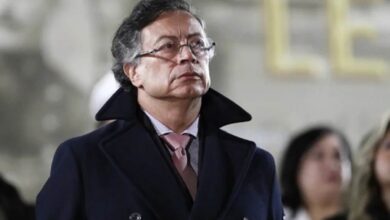Interview with Juan Pablo Socarrás: When Fashion, Identity and Sustainability Converge
Colombian designer Juan Pablo Socarrás tells us about his effort to show the world the hidden talents of nomadic peoples and women in the country.

He is one of the most prominent fashion designers of the last decade in Latin America, who, as a participant observation, gets involved in indigenous communities of the vast Colombian territory to exchange knowledge, and make visible the hidden talents of these peoples. Photo: IG-juanpablosocarras, IG-camilo.forerop
LatinAmerican Post | Carlo Mario Torres Nieves
Listen to this article
Leer en español: Entrevista a Juan Pablo Socarrás: Así convergen la moda, la identidad y la sostenibilidad
Inside a small plane that was measured to the task of traveling 502 kilometers away, from the capital of Colombia to the wild Amazon region, Juan Pablo Socarrás embarked on the magical adventure of going in the footsteps of women with stories to tell. Socarrás is not a photojournalist, nor an expeditionist or mad scientist in search of minerals for his next invention.
He is one of the most prominent fashion designers of the last decade in Latin America, who, as a participant observation, gets involved in indigenous communities of the vast Colombian territory to exchange knowledge and make visible the hidden talents of these peoples. For this reason, it is understood that colored markers, fashion magazines, notebooks, cardboard and glue predominate in his luggage, instead of the clothing and protective equipment required to immerse yourself in the virginity of the most remote settings of Putumayo (South).
Read also: A Brief History Of Political Gestures At the Met Gala
He himself affirms that: "When I start these tours I have no expectations. I just really want to arrive and discover; to fall in love with their smiles." And how can he not do it? If 16 years of work with ancestral communities have allowed him to understand that the best way to impact the lives of others is the innocent look at cultural processes of great value. For this reason, in a brief pause on this expedition through Colombia with his most recent project: “Stories Made by Hand”, we talked with the human being, with the artist, with Juan Pablo Socarrás.
LatinAmerican Post : To what do you attribute your passion for exalting the ancestral techniques of design and clothing in Colombia?
Juan Pablo Socarrás : When I started very young in this profession, I did it with Artesanías de Colombia, which gave me the opportunity to travel the world, and to show that world the product, techniques and ancestral crafts of my country. Today, after having retired from that institution, I continue to dedicate myself to promoting, telling and helping everyone know abroad that there is a country full of stories. For this reason, experimenting, traveling, knowing and now walking for sustainability are one of the most important principles of my life.
LP : What have been the challenges you usually face when approaching these towns?
JPS : When I start these tours I have no expectations. I just really want to get there and get to know; to fall in love with their smiles. In fact, I recently completed a series of visits by four indigenous communities; it was a long and hard week but one of wonderful learnings. I was in the Caña Bravita displacement community, it is a community of Emberas displaced by several generations. Later I was in the Las Aguas community, they are displaced people from the department of Nariño, full of a lot of magic. The latter is located in the village of Agua Blanca in Putumayo. I put you in context; every day he had to travel two hours from Puerto Asís to reach the community. I also worked with the community of Los Pastos, and the Inca-Kamsa. All were displaced by violence at some point, and are now settled in Putumayo. They are nomadic communities that, some prevail and tell their stories, and others have lost it, and that leaves me a bit worried, but it also leaves me with the task of continuing to strengthen them.
LP : Have you ever felt like throwing in the towel?
JPS : In many opportunities of my life I have wanted to throw in the towel, but these projects motivate me, these women motivate me, traveling through Colombia motivates me and getting to know each of the communities, their trades, our stories and our ancestors … that's what that makes me very very happy.
LP : What can you highlight about the work of incorporating into your creative and production team women who gave up their weapons and yearn to join civil society as the new talents of design?
JPS : I have worked with women in difficult contexts, not only demobilized, but also reintegrated and immigrants. I believe that in the end I do not see them from their past but from their present and future full of opportunities. I have always said that I am like Switzerland: I have the opportunity to be seated with a community of displaced people, who at some point were paramilitaries or victims, and then be in other spaces of artisan communities … What I see in them is how to start together so that their lives are different.
LP : How do you guide all of the above towards sustainability?
JPS : In my most recent collection, the Coca-Cola company not only sponsored me, but taught me to walk on sustainability. This world that is not perfect is a utopian world. But the transformation of materials like rPET and others that Coca-Cola has given me to transform, along with these women, has given me the opportunity to put a new use for the things that people throw away. I have transformed this global trend of supra-recycling into fabrics, which were once bottles. Fabrics that for a T-shirt you need five bottles. So, I have learned that sustainability is in everything: in the handling of materials, in the management of the community, in the economic part, in many points; and this project has it.
LP : What is your challenge as a designer to take care of the environment?
JPS : This is not only a challenge for me, but also for Colombians and the whole world. We have to understand that planet earth is the place where we live and if you don't take care of your house, if you don't love it, if you don't do something about it, it tends to disappear or us. So, more than a commitment as a designer, it is a commitment as a human being and a citizen of this country that I walk daily.
LP : Finally, from your worldview as an artist, how do you define today's Colombia?
JPS : I define today's Colombia as the best kept secret in the world. Definitely, the world could visit us and find so many stories, products, communities and experiences that they would not want to leave Colombia. We have everything for tourism, gastronomy, fashion and design to be at the forefront in everything; we are the best secret.





